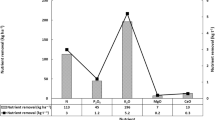Abstract
Effects of three levels of applied nitrogen and 4- and 8-week intervals between cuts on the nitrogen, phosphorus, potassium, calcium, magnesium and sodium content and yield of four grasses grown in field swards were studied in three full harvest years. Concentrations of elements in herbage lower than those required by some classes of livestock were found as follows: in the case of phosphorus, where high yields of grass were obtained without any very recent application of phosphorus; in the case of calcium, mainly at harvests in late April/early May; in the case of magnesium, in most of the grass harvested in April, May, June and July; in the case of sodium, where no nitrogen or the intermediate level was applied, except at the October/November harvests; in the case of nitrogen, at harvests in May and July with the 8-week interval and no applied N. Suggestions are made as to ways of raising the concentrations where necessary. The concentration of potassium in herbage was greatly in excess of animal requirements; possible ways of economizing on potassium application are considered. Applied nitrogen (as ‘Nitro-chalk’) greatly reduced extractable soil potassium, reduced soil magnesium, and had little or no effect on soil calcium, sodium or pH.
Similar content being viewed by others
References
Agricultural Research Council (1980) The nutrient requirements of ruminant livestock. Published on behalf of the Agricultural Research Council by the Commonwealth Agricultural Bureaux, Farnham Royal
Butler GW and Jones DIH (1973) Mineral biochemistry of herbage. In Butler GW and Bailey RW eds. Chemistry and biochemistry of herbage, Vol 2, pp 127–162. London: Academic Press
Cooke GW (1967) The control of soil fertility. London: Crosby Lockwood
Faithfull NT (1971) Automated simultaneous determination of nitrogen, phosphorus, potassium and calcium on the same herbage digest solution. Laboratory Practice 20, 41–44
Faithfull NT (1974) The analysis of magnesium in herbage Kjeldahl digests by atomic absorption spectrophotometry with the nitrous oxide/acetylene flame. Laboratory Practice 23, 177–178
Kemp A (1960) Hypomagnesaemia in milking cows: the response of serum magnesium to alterations in herbage composition resulting from potash and nitrogen dressings on pasture. Netherlands Journal of Agricultural Science 8, 281–304
Ministry of Agriculture, Fisheries and Food (1973) The analysis of agricultural materials. Technical Bulletin 27. London: HMSO
Mzamane N (1980) The content, yield and availability of some major elements in grasses and herbage legumes. Ph D thesis, University College of Wales, Aberystwyth
Thomas B, Thompson A, Oyenuga VA and Armstrong RH (1952) The ash constituents of some herbage plants at different stages of maturity. Empire Journal of Experimental Agriculture 20, 10–22
Welsh Plant Breeding Station (1979) Report of Welsh Plant Breeding Station for 1978, p 279
Welsh Plant Breeding Station (1980) Report of Welsh Plant Breeding Station for 1979, p 254
Whitehead DC (1966) Nutrient minerals in grassland herbage. Mimeographed publication 1/1966, Commonwealth Bureau of Pastures and Field Crops. Farnham Royal: Commonwealth Agricultural Bureaux
Wilman D (1975) Nitrogen and Italian ryegrass. 1. Growth up to 14 weeks: drymatter yield and digestibility. J British Grassland Soc 30, 141–147
Wilman D (1975) Nitrogen and Italian ryegrass. 2. Growth up to 14 weeks: nitrogen, phosphorus and potassium content and yield. J British Grassland Soc 30, 243–249
Wilman D, Droushiotis D, Koocheki A, Lwoga AB and Shim JS (1976) The effect of interval between harvests and nitrogen application on the digestibility and digestible yield and nitrogen content and yield of four ryegrass varieties in the first harvest year. J Agric Sci Camb 86, 393–399
Wilman D, Koocheki A and Lwoga AB (1976) The effect of interval between harvests and nitrogen application on the proportion and yield of crop fractions and on the digestibility and digestible yield and nitrogen content and yield of two perennial ryegrass varieties in the second harvest year. J Agric Sci Camb 87, 59–74
Wilman D and Mohamed AA (1980) Response to nitrogen application and interval between harvests in five grasses — 1. Dry-matter yield, nitrogen content and yield, numbers and weights of tillers, and proportion of crop fractions. Fertilizer Research 1, 245–263
Wilman D and Mohamed AA (1981) Response to nitrogen application and interval between harvests in five grasses — 2. Leaf development. Fertilizer Research 2, 3–20
Author information
Authors and Affiliations
Rights and permissions
About this article
Cite this article
Wilman, D., Mzamane, N. The content and yield of six elements in four grasses as affected by nitrogen application and interval between harvests. Fertilizer Research 3, 97–110 (1982). https://doi.org/10.1007/BF01082971
Issue Date:
DOI: https://doi.org/10.1007/BF01082971




